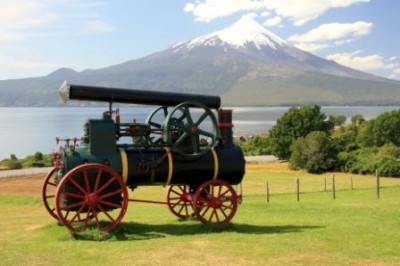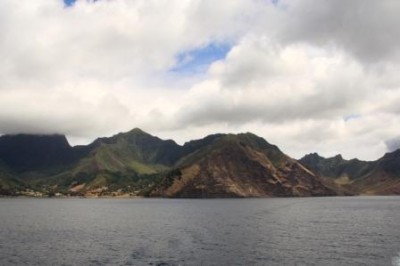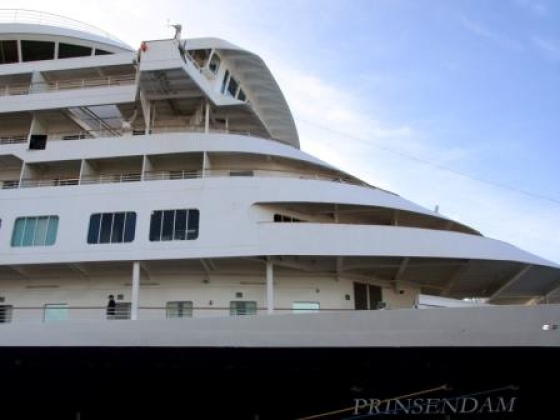No, there is no Lake Robinson, at least, not as far as I know. This report is about the “Lake District” and ‘Robinson Crusoe Island”, but I better start with Crux. Observing the Southern Cross, on a starry, starry night, has been one of my (secondary) objectives. One may wonder why it had to take this long (48 nights …) to finally find and see alpha, beta, gamma, delta and epsilon in their red, orange, silver and blue dresses, marveling at the naked beauty of these heavenly bodies. To be sure, there were no forty eight nights to observe them, not even half of that number but, unless one explicitly decides, “now or never”, if it is a good viewing night, one often, if not always, postpones: I will do it tomorrow….
The dry air and the clear skies were still with us when we arrived in Puerto Montt, a sort of capital of the so-called Lake District. This region is still considered “Southern Chili”, as in sparsely populated and economically undeveloped. It groups a number of big blue lakes of volcanic origin, a few predominantly (central) European-settled towns and protected wilderness. From here to Santiago is a twelve hour drive, and to Punta Arenas there is a regular bus, thirty-five hours, up and down, on the East site of the Cordillera, via a route that straddles the border. The world as we know it, is still far away!
The guide started by telling us how lucky we really were. After all it rains 200 days per year for a total of 60in, or 1800mm. Living n the epicenter of the Western European Rain Dominions, I know that with those statistics, the chances for a blue sky day are slim indeed. As a matter of fact, the previous day they enjoyed an all-time record warm temperature, breaking the 1942 mark. The new one stands at 86*F/30°C.
The excursion took us a little north, and then east to the Argentinean border – Chile measures here, as in many places, less than 60 miles across. The lakes have been formed by volcanic activity. The first one, also the biggest in Chile, has an exquisite name that I cannot get stored in my long term memory. Measuring about 350 square miles, it is called “Lago Llanquihué”, with obvious Indian roots. My end point was another one, cozier and easier to remember: All Saints Lake (obviously no Indian roots). Nature has certainly done a great job at landscaping in this neck of the woods: snow-topped volcanoes (with all kinds of “tops”, including the blown-off variety), emerald lakes, all shades of green trees, lots of colorful flowers … while a matching infrastructure is still lacking, it is a pleasure for the eyes.
 Driving past the various lake beaches on a summer Sunday afternoon, I was struck by the skin color of the locals: contrary to other parts of South America that I have visited so far, the general tendency was for pale skins. Indeed, I have seen a few real redheads, as they also sported authentic freckles! I have been told that very few Indians (Mapiche) survived the early colonization and that the area, from the coast all the way to the Lake Llanquihue, has been settled by Germans primarily. Traces of that influence could be seen in building styles and store names. I also detected a fire brigade truck that had “Feuerwehr” written across it!
Driving past the various lake beaches on a summer Sunday afternoon, I was struck by the skin color of the locals: contrary to other parts of South America that I have visited so far, the general tendency was for pale skins. Indeed, I have seen a few real redheads, as they also sported authentic freckles! I have been told that very few Indians (Mapiche) survived the early colonization and that the area, from the coast all the way to the Lake Llanquihue, has been settled by Germans primarily. Traces of that influence could be seen in building styles and store names. I also detected a fire brigade truck that had “Feuerwehr” written across it!
Lastly, let me mention my first (and implicitly not my last) Pisco experience! No, Pisco has nothing in common with Cuzco, or any other Inca treasure, it is the national drink (also in Peru). The ship’s management had warned us though, in writing no less, about the dangers of consuming local Pisco. It wasn’t the “Pisco” itself (akin to Italian Grappa) that poses a direct health problem, although it is 100 Proof, but rather the other ingredients. The most critical is egg white and many a “mariner” had been taken ill over the years by spoiled eggs. We found a place, right in front of the gorgeous Volcan Isorno, (where they also sported an old German steam machine), with live chickens! Re-assured about the eggs, we indulged in a refreshingly potent and potently refreshing Pisco. Here comes the recipe:
Take eight parts of Pisco, four parts lime juice, three parts of syrup (the type defines the name of the Pisco, e.g. mango, green chilies, cinnamon & honey, avocado, mint, pineapple) and one raw egg white. Shake well with ice, strain in a glass. Salud! After our Pisco, we returned to the ship to promptly set sail for our next destination, seven hundred miles away, in the South Pacific.
Looking at maps of emptiness requires a special “setback switch”, for a ship is not a car and the scale plays games with our habits. The attraction “next door” is thirty-six hours away. Moreover, going west in the evening, and almost turn back on a dime, costs daylight hours. Nobody is counting of course, but the discrete changes in sunrise and sunset times, are substantial, raising an attentive eyebrow or two.
We arrived at Robinson Crusoe Island when it was still pitch dark. The sun was supposed to rise at 0810. We were anchored within shouting distance from the “capital” by 0730. Apparently the ship’s carpenters had to get to work on the pier infrastructure before we could safely get to land. There were no scheduled excursions; after all the place measured barely ten square miles.
This island, plus another two that constitute the Juan Fernandez archipelago, named after their Spanish discoverer (1574), saw its first (Swiss) settlers in 1877. The only noteworthy event of the intervening three hundred years was the “arrival” of Alexander Selkirk in 1704. He was dropped – at his request! – on the beach because he did not trust the seaworthiness, nor the captain’s skills of a ship en route to Peru. The ship sank a few months later off the Peruvian Coast and Alexander got plucked off the island by a rare passer-by in 1708, four years and four months after having chosen his new domicile.
Daniel Defoe, an erstwhile relatively obscure English writer, must have heard the story, presumably from Selkirk himself, and created the Robinson Crusoe bestseller. That is why, apart from romanticizing the adventure, some survival (and surviving) attributes of Robinson, alias Alexander, can be visited, most notably his cave and his outlook. The former is on a gently-sloping beach, just a few feet above the waterline. The latter is a saddle on the mountain ridge, 1800ft (600m) above sea level.
When I had been planning y walk the previous day, the idea was to set out for a three hour roundabout of the island, not unlike what I had done at Devil’s Island – it seems already an eternity ago. When the shuttle was ready to get us to shore, the sun was rising and the plan had to be shelved. San Juan Bautista, the only port and home for the six hundred inhabitants, resembled a huge stadium, hemmed in by steep walls on all sides. Any kind of walk had to be up, and then down again.
 Rather than spending time in the tourist area with all the gift shops (imported from the mainland), I decided to go for gold: Alexander’s Lookout or “Mirador Selkirk”. The info board stated 2700m. Since that could not be the height, it had to be the length. After fifteen minutes uphill I had left the houses behind me, as well as all (imagined) competitors. Another fifteen minutes and my heartbeat was way up and my shirt started to change color. The first patch of rain forest had been traversed and, the path turned less steep. Another half a mile I detected a lookout point, a couple of hundred meters below the saddle.
Rather than spending time in the tourist area with all the gift shops (imported from the mainland), I decided to go for gold: Alexander’s Lookout or “Mirador Selkirk”. The info board stated 2700m. Since that could not be the height, it had to be the length. After fifteen minutes uphill I had left the houses behind me, as well as all (imagined) competitors. Another fifteen minutes and my heartbeat was way up and my shirt started to change color. The first patch of rain forest had been traversed and, the path turned less steep. Another half a mile I detected a lookout point, a couple of hundred meters below the saddle.
By now, I had walked almost an hour and rain had set in (it would come and go four times in as many hours). Because my phone did not work and the going became more slippery, I decided to wait for the next pack of “climbers”. It soon became obvious that the pack would number zero, and I reluctantly turned back. I had enough excuses, the more important one that the ship would not wait if I did not make it back in time; nor would they have an easy way to figure out where I was… because the few birds that kept me company, were not of the messenger type.
After a rather tricky descent, straining the knees and calf muscles beyond what they have recently experienced, I arrived back in the village. The “spiny lobster catchers” appeared to be carrying much more Indian genes than what I had seen on the mainland thus far. To compensate for that, the island was full of Irish-colored dogs (no freckles though), in all sizes and shapes. They all had neckband but behaved like stray dogs (shared by the entire community perhaps?). They were quite friendly though and many visitors, including myself, were followed by one and the same dog, all the time until they left the pier – a live replica perhaps of Robinson’s guardian angel?!
Robinson Crusoe Island is, when you are in the neighborhood, worthy of a visit. In the summer it enjoys pleasant weather, with a sprinkling never far away. That explains the exquisite shades of green that cover the steep volcanic walls. The rock formations infiltrate the green tapestry with variations of yellow: from a whitish sand color, over ochre to orange yellow and igneous dark. It all makes that cruising around the island produces some remarkable pictures. And you can get a shot at Alexander’s cave as well!
Prinsendam, Day 51 – Thursday, Feb 24th, 2011
En route to Aconcagua

